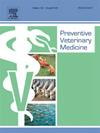Farmers who implemented this, also implemented that: Use of association-rule-learning to improve biosecurity on dairies
IF 2.4
2区 农林科学
Q1 VETERINARY SCIENCES
引用次数: 0
Abstract
Biosecurity practices are the cornerstone of disease prevention and control programs. In Canada, their implementation is evaluated with a Risk Assessment Questionnaire (RAQ). Association Rule Learning (ARL) – a non-supervised machine learning algorithm – is widely used in marketing for consumer segmentation based on purchase patterns. This technique may help veterinarians to recommend biosecurity practices that are more likely to be adopted by producers. In this project, we applied ARL to 3825 RAQ completed by Québec dairy producers to generate 22 million rules that identified combinations of self-reported practices frequently applied together. We retained the best 63 rules predicting the adoption of 13 biosecurity practices with a confidence ≥ 70 %. ARL is useful in studying the relationship between biosecurity practices on dairy farms. By identifying biosecurity practices more likely to be implemented by a given producer, veterinarians can provide targeted recommendations that might improve disease prevention and control programs.
实施了这个的农民,也实施了那个:使用关联规则学习来提高奶牛场的生物安全
生物安全措施是疾病预防和控制项目的基石。在加拿大,通过风险评估问卷(RAQ)对其实施情况进行评估。关联规则学习(ARL)是一种非监督机器学习算法,广泛应用于基于购买模式的消费者细分市场。这项技术可以帮助兽医推荐更有可能被生产者采用的生物安全措施。在这个项目中,我们将ARL应用于由quamezbec乳制品生产商完成的3825个RAQ,以生成2200万条规则,这些规则确定了经常应用在一起的自我报告实践的组合。我们保留了预测13种生物安全实践采用的最佳63条规则,置信度≥ 70 %。ARL在研究奶牛场生物安全措施之间的关系方面很有用。通过确定更有可能由特定生产商实施的生物安全措施,兽医可以提供有针对性的建议,可能会改善疾病预防和控制计划。
本文章由计算机程序翻译,如有差异,请以英文原文为准。
求助全文
约1分钟内获得全文
求助全文
来源期刊

Preventive veterinary medicine
农林科学-兽医学
CiteScore
5.60
自引率
7.70%
发文量
184
审稿时长
3 months
期刊介绍:
Preventive Veterinary Medicine is one of the leading international resources for scientific reports on animal health programs and preventive veterinary medicine. The journal follows the guidelines for standardizing and strengthening the reporting of biomedical research which are available from the CONSORT, MOOSE, PRISMA, REFLECT, STARD, and STROBE statements. The journal focuses on:
Epidemiology of health events relevant to domestic and wild animals;
Economic impacts of epidemic and endemic animal and zoonotic diseases;
Latest methods and approaches in veterinary epidemiology;
Disease and infection control or eradication measures;
The "One Health" concept and the relationships between veterinary medicine, human health, animal-production systems, and the environment;
Development of new techniques in surveillance systems and diagnosis;
Evaluation and control of diseases in animal populations.
 求助内容:
求助内容: 应助结果提醒方式:
应助结果提醒方式:


